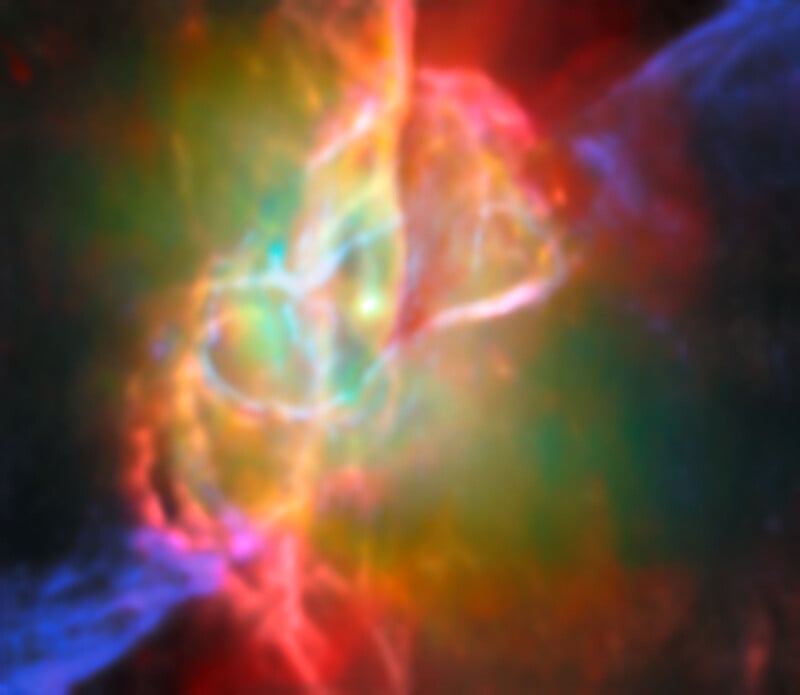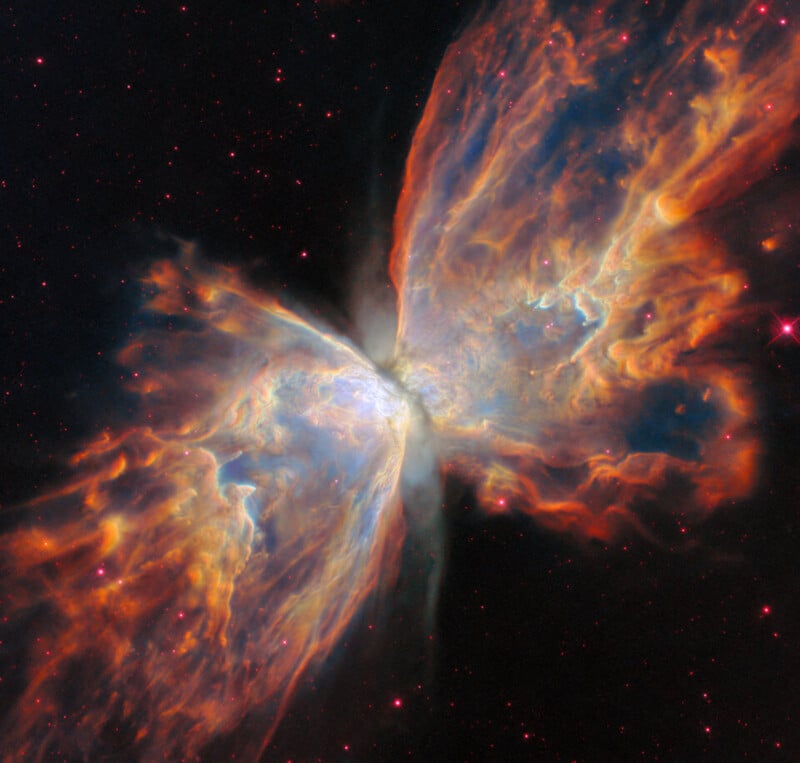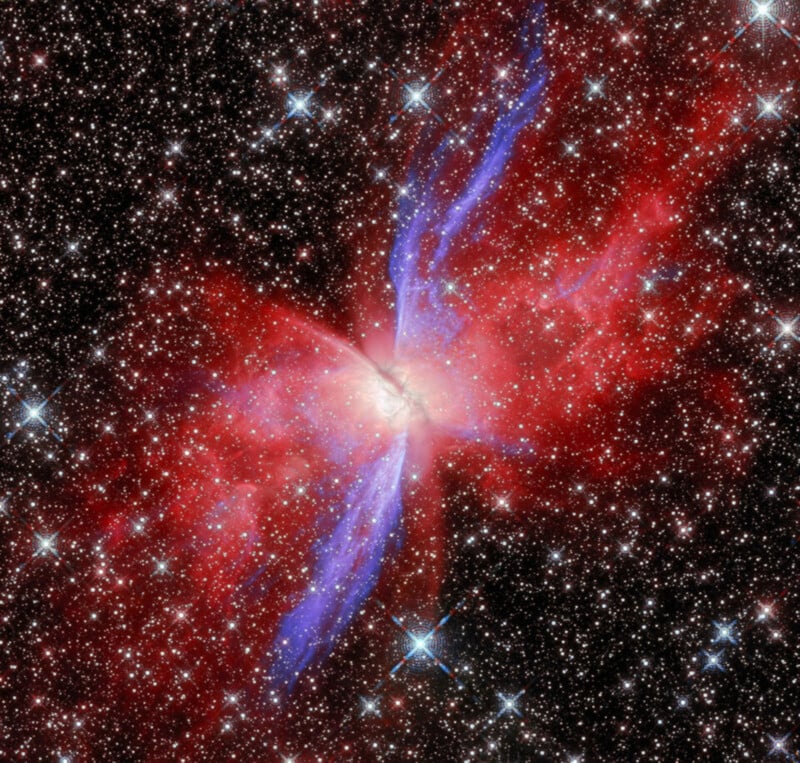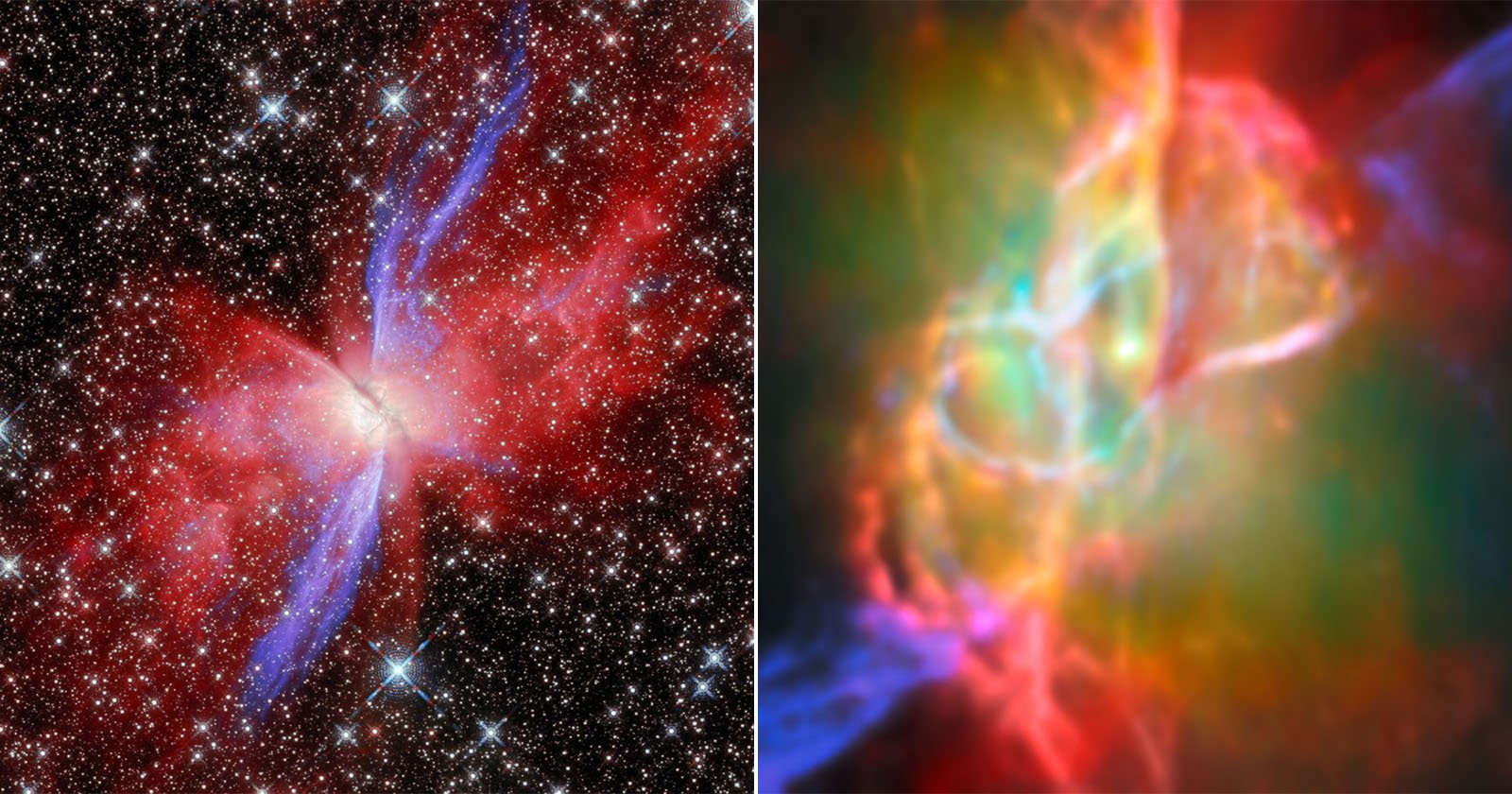 Butterfly Nebula NGC 6302 (Webb & ALMA image) |
Butterfly Nebula NGC 6302 (Webb & ALMA image) |
ESA/Webb, NASA & CSA, M. Matsuura, ALMA (ESO/NAOJ/NRAO), N. Hirano, M. Zamani (ESA/Webb)
The NASA/ESA/CSA James Webb Space Telescope (JWST) peered at the Butterfly Nebula using its Mid-InfraRed Instrument (MIRI) camera, uncovering never-before-seen details of the nebula’s heart. This is the first time scientists have seen the super-hot star powering the beautiful, bug-like nebula.
The Butterfly Nebula, also known as NGC 6302, is located about 3,400 light-years away in the constellation Scorpius. Given its relatively close proximity, it is a common target for astronomers and telescopes, including the Hubble Space Telescope. Now the $10 billion James Webb Space Telescope has set its sights on the nebula, putting its superior infrared technology to the test.
“Planetary nebulas are among the most beautiful and most elusive creatures in the cosmic zoo. These nebulas form when stars with masses between about 0.8 and 8 times the mass of the Sun shed most of their mass at the end of their lives,” the European Space Agency (ESA) explains. “The planetary nebula phase is fleeting, lasting only about 20,000 years.”
 Butterfly Nebula NGC 6302 (Hubble, Webb & ALMA images) | ESA/Webb, NASA & CSA, M. Matsuura, J. Kastner, K. Noll, ALMA (ESO/NAOJ/NRAO), N. Hirano, J. Kastner, M. Zamani (ESA/Webb)
Butterfly Nebula NGC 6302 (Hubble, Webb & ALMA images) | ESA/Webb, NASA & CSA, M. Matsuura, J. Kastner, K. Noll, ALMA (ESO/NAOJ/NRAO), N. Hirano, J. Kastner, M. Zamani (ESA/Webb)
Despite their name, planetary nebulae are not related to planets at all. The name originates from a bygone era when astronomers observed that planetary nebulae resembled planets due to their round appearance. But as the Butterfly Nebula demonstrates, planetary nebulae can take all sorts of shapes, including some that are decidedly not planet-like at all.
The Butterfly Nebula is a “bipolar nebula,” which, as ESA explains, means “that it has two lobes that spread in opposite directions, forming the ‘wings’ of the butterfly.” When viewed in many wavelengths of light, such as optical and near-infrared light by Hubble, the Butterfly Nebula really does look like a butterfly. It’s really stunning.
 Butterfly Nebula NGC 6302 Hubble Optical
Butterfly Nebula NGC 6302 Hubble Optical  Butterfly Nebula NGC 6302 Hubble Near-Infrared
Butterfly Nebula NGC 6302 Hubble Near-Infrared
The dark band of dusty gas, which forms the “butterfly’s” body, is a donut-shaped torus. This is typically obscured by cosmic gas and dust.
However, thanks to Webb’s MIRI, it is possible to see through the dust and see the vibrant, bright, and twisting torus. Researchers can also see the Butterfly Nebula’s central star, which scientists previously could not precisely locate because of the shroud of dust surrounding it. When scientists have previously searched for the star, they came up empty because cameras lacked the resolution and infrared sensitivity necessary to see it. The central star is exceptionally hot, with a temperature of around 220,000 Kelvin. It is one of the hottest known central stars of any planetary nebula in the Milky Way Galaxy.
The team of researchers, led by Mikako Matsuura, also detected polycyclic aromatic hydrocarbons, or PAHs. This could be the first time PAHs have been detected in an oxygen-rich planetary nebula like NGC 6302.
Image credits: ESA/Webb, NASA & CSA, M. Matsuura, J. Kastner, K. Noll, ALMA (ESO/NAOJ/NRAO), N. Hirano, J. Kastner, M. Zamani (ESA/Webb). The images were captured as part of new research, “The JWST/MIRI view of the planetary nebula NGC 6302 — I. A UV-irradiated torus and a hot bubble triggering PAH formation,” which was written by Mikako Matsuura et. al. and published in “Monthly Notices of the Royal Astronomical Society.”
